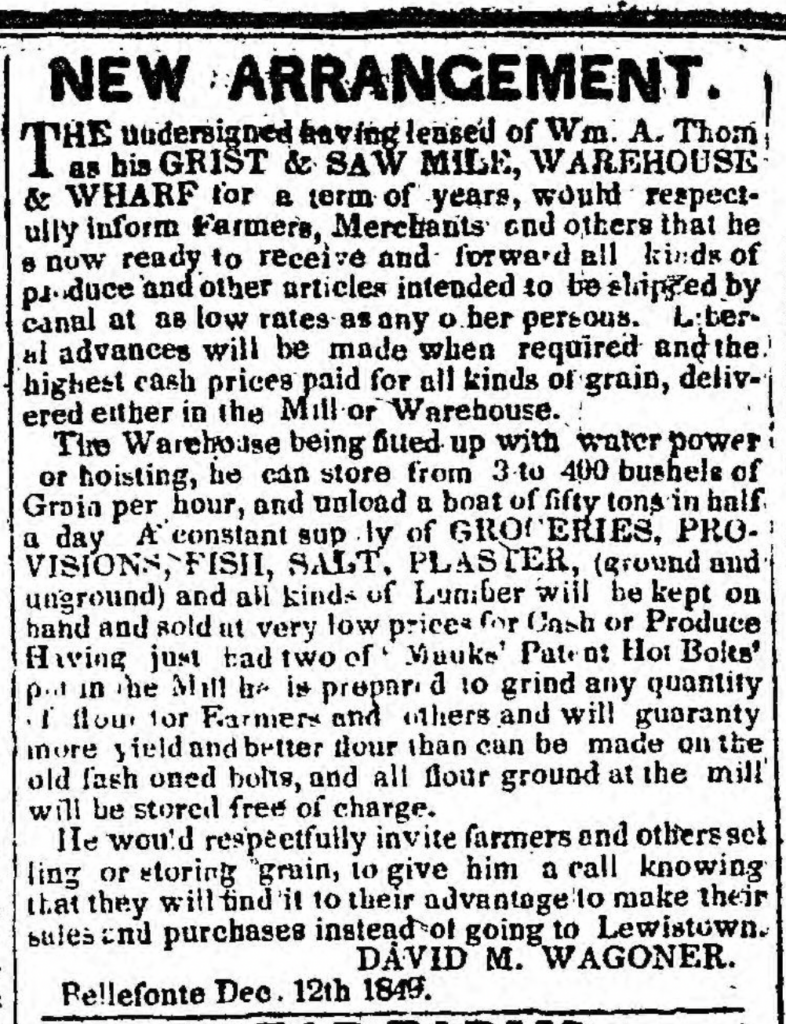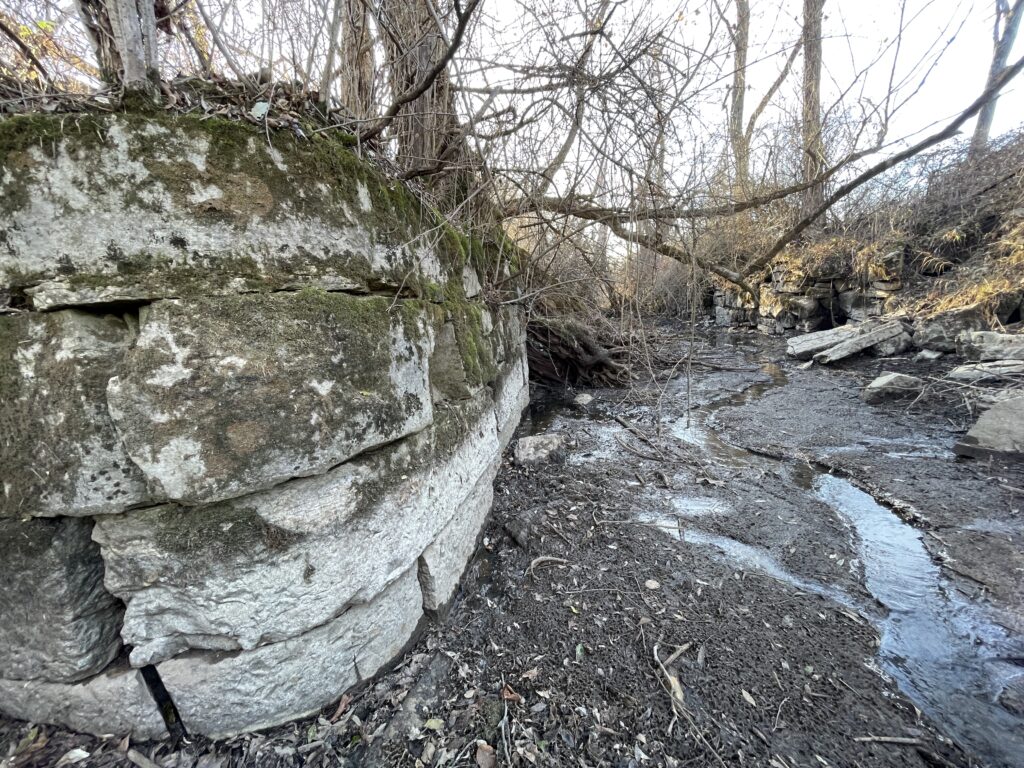In 1848, the first canal boat—the “George Crane”—arrived at Bellefonte from Milesburg with a celebratory crew of locals and board members of the Bald Eagle and Spring Creek Navigation Company. The board members included owners and partners representing Eagle Iron Works, Valentine and Thomas Iron Works, Howard Furnace, Centre Furnace, and Milesburg Iron Works (Linn & McCoy). Among others, the party likely included Roland Curtin, Gen. James Irvin, and William A. Thomas.
A few days later, a boat called the “Jane Curtin,” under Captain William White, arrived from Eagle Iron Works with a load for Valentine and Thomas as well as other merchandise. The boat’s namesake was Jane Gregg Curtin, daughter of Andrew Gregg, wife of Roland Curtin, and mother of Governor Andrew Gregg Curtin.
Fourteen years prior to this celebration on Bellefonte’s canal wharf near today’s Lamb Street bridge, William A. Thomas and the other citizens had formed the Bald Eagle and Spring Creek Navigation Company in 1834. This was about the same time that Thomas acquired the gristmill known today as the Gamble Mill in Bellefonte. Thomas is well-known in Centre County history for his active role in assisting freedom seekers on the Underground Railroad. He owned significant amounts of property and was engaged in iron production with the Valentine brothers as Valentine, Thomas, and Co.
Thomas also owned a “Warehouse and Wharf” next to his grist and saw mills along Spring Creek. An 1849 advertisement informed “farmers, merchants, and others” that they were “ready to receive and forward all kinds of produce and other articles intended to be shipped by canal.” In addition, they were able to “unload a boat of fifty tons in half a day” at the old canal warehouse. Unfortunately, it burned down in 1892, taking with it the original Thomas Mill.

The Canal Era was a brief but fascinating chapter in Pennsylvania’s history. Strong-minded mules pulled canal boats loaded with iron, lumber, coal, grains, pianos, and other freight along towpaths. Resourceful “canalers” and sometimes their families earned a difficult but quiet living. Horses pulled packet boats of curious passengers, conveying them through locks, over aqueducts, and under low bridges to their destinations along the waterways. Citizens in Centre County, especially ironmasters, understood the benefits of investing in these public works and were among those to catch “canal fever.”
After the successful completion of the Erie Canal in 1825, the commonwealth of Pennsylvania’s legislature approved a canal public works project the following year. Pennsylvania built hundreds of miles of canal, mostly with Irish immigrant labor, to create its Main Line Canal by 1834, the same year that the Allegheny Portage Railroad opened, connecting Philadelphia and Pittsburgh at last by a unique combination of canals and early railroads. Other state canal lines weaved their way along Pennsylvania’s watersheds from the “Main Line.”
The Susquehanna Division worked its way from Clark’s Ferry up to Northumberland. Clark’s Ferry is where Charles Dickens, as a passenger in 1842, described an aqueduct along his journey over the Susquehanna River as “an extraordinary wooden bridge with two galleries, one above the other, so that, even there, two boat-teams meeting may pass without confusion—it was wild and grand.”
From Northumberland, the West Branch Division of the canal meandered upward through Lewisburg and Muncy, then westward to Williamsport, Jersey Shore, and Lock Haven. As construction continued in 1833, “one or two riots” occurred between Irish laborers and boatmen at “Great Island” (Lock Haven). The chaos was started by the “pulling” of some apples from a widow’s field and escalated until the militia was called in to quell it. Nevertheless, this West Branch Division was completed to Lock Haven by 1835.

The remnants of BESCN Lock No. 15 Bullit Run at Mt. Eagle (Photo by Local Historia)
With the state canal system in sight, the Bald Eagle and Spring Creek Navigation Company was incorporated in 1834 to construct a private canal extending from Lock Haven through the Bald Eagle Valley to Bellefonte under the auspices of M.R. Stealey, principal engineer. Twenty-eight locks ascended about 183 feet in lockage over 25 miles from Lock Haven through Mill Hall, Beach Creek, Eagleville, Blanchard, Howard, and Mt. Eagle (see photo of Lock #15 ruins) to nearby Eagle Iron Works (Curtin Village) and Milesburg to its terminus in Bellefonte. The Lower Division from Lock Haven to Howard was completed by 1837, to Milesburg in 1847, and finally to the Bellefonte wharf in 1848.
Both rising flood waters and the inevitable tide of railroad dominance would lead to the canal’s demise around 1865. While short-lived, the canal extension made Centre County and its iron industry an essential destination in Pennsylvania history once again. T&G
Local Historia is a passion for local history, community, and preservation. Its mission is to connect you with local history through engaging content and walking tours. Local Historia is owned by public historians Matt Maris and Dustin Elder, who co-author this column. For more, visit localhistoria.com.
Sources:
Bald Eagle and Spring Creek Navigation Company. (1835). The first report of the President and managers to the Legislature of Pennsylvania, and the stock holders. [N.p.].
Charcoal cold blast furnace, Hecla Furnace (Milesburgh, Pa.), 1870-1913, 1986268_0135, American Iron and Steel Institute photographs and audiovisual materials (Accession 1986.268), Audiovisual Collections and Digital Initiatives Department, Hagley Museum and Library, Wilmington, DE 19807.
Linn, John B. History of Centre and Clinton Counties, Pennsylvania. Philadelphia: Louis H. Everts, 1883.
“New Arrangement.” Centre Democrat (Bellefonte, PA), March 26, 1851.
Shank, William H. The Amazing Pennsylvania Canals. York, PA: American Canal and Transportation Center, 1991.
Stroud, Andrew E. PACanals: 2018 Progress Report. July 2018.




